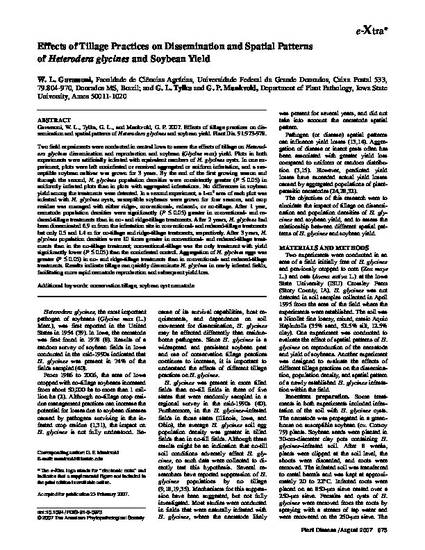
Two field experiments were conducted in central Iowa to assess the effects of tillage on Heterodera glycines dissemination and reproduction and soybean (Glycine max) yield. Plots in both experiments were artificially infested with equivalent numbers of H. glycinescysts. In one experiment, plots were left noninfested or received aggregated or uniform infestation, and a susceptible soybean cultivar was grown for 3 years. By the end of the first growing season and through the second, H. glycines population densities were consistently greater (P ≤ 0.05) in uniformly infested plots than in plots with aggregated infestations. No differences in soybean yield among the treatments were detected. In a second experiment, a 1-m2 area of each plot was infested with H. glycines cysts, susceptible soybeans were grown for four seasons, and crop residue was managed with either ridge-, conventional-, reduced-, or no-tillage. After 1 year, nematode population densities were significantly (P ≤ 0.05) greater in conventional- and reduced-tillage treatments than in no- and ridge-tillage treatments. After 2 years, H. glycines had been disseminated 6.9 m from the infestation site in conventional- and reduced-tillage treatments but only 0.5 and 1.4 m for no-tillage and ridge-tillage treatments, respectively. After 3 years, H. glycines population densities were 10 times greater in conventional- and reduced-tillage treatments than in the no-tillage treatment; conventional-tillage was the only treatment with yield significantly lower (P ≤ 0.05) than the noninfested control. Aggregation of H. glycines eggs was greater (P ≤ 0.05) in no- and ridge-tillage treatments than in conventional- and reduced-tillage treatments. Results indicate tillage can quickly disseminate H. glycines in newly infested fields, facilitating more rapid nematode reproduction and subsequent yield loss.
Available at: http://works.bepress.com/gary_munkvold/132/

This article is published as Gavassoni, W. L., G. L. Tylka, and G. P. Munkvold. "Effects of tillage practices on dissemination and spatial patterns of Heterodera glycines and soybean yield." Plant disease 91, no. 8 (2007): 973-978, doi: 10.1094/PDIS-91-8-0973. Posted with permission.